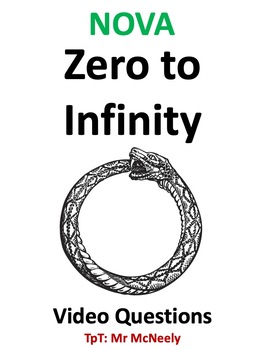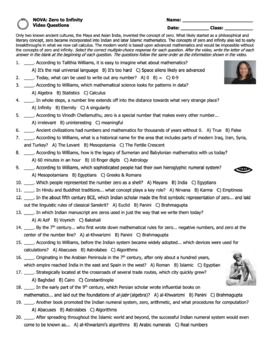NOVA: Zero to Infinity Video Questions Worksheet
- Zip
Also included in
- This single download contains, at a discounted price, video worksheets to accompany six NOVA documentaries about the history and uses of mathematics. The topics include the Great Math Mystery and the "unreasonable effectiveness" of math (The Great Math Mystery), fractal geometry as a way to model naPrice $9.00Original Price $12.00Save $3.00
Description
Only two known ancient cultures, the Maya and Asian India, invented the concept of zero. Likely starting as a philosophical and literary concept, zero became incorporated into Indian and later Islamic mathematics. The concepts of zero and infinity also led to early breakthroughs in what we now call calculus. The modern world is based upon advanced mathematics and would be impossible without the concepts of zero and infinity.
The worksheet consists of 45 multiple choice questions that follow the video, and a key is included. The zip file download features MS Word and PDF versions of the video questions. You will need to obtain a DVD of the video or locate an internet site for streaming.
A Google Forms self-grading quiz of the video questions is available here. (Note: Access to the Google Quiz requires an extra payment.)
The video is available for streaming on the PBS internet site. (Please make sure that the video is accessible before purchasing this TPT resource.)
Overview: NOVA: Zero to Infinity
According to mathematician Talithia Williams, mathematics seems like a real universal language. With today’s mathematics, virtually any number can be written with the digits ranging from 0 to 9 which were derived from ancient India and transmitted via the Islamic Empire (and are today named “Arabic” numerals). Most ancient civilizations did not use zero in their number systems. Only the ancient Mayan and Indiana civilizations are known to have invented zero. The Maya symbolized zero with a glyph shaped like a shell. With ancient India, zero was likely a literary and philosophical concept (emptiness). In the fifth century BCE, the Indian scholar and Sanskrit linguist Panini made the first symbolic representation of zero. Later, in the 7th century, the Indian scholar and astronomer Brahmagupta first wrote down rules used in mathematics for negative numbers and zero on a number line. Before the Indian system became widely adopted, numbers were used mainly for counting using devices such as the abacus. In the 7th century, the Islamic Empire emerged from Arabia and in a hundred years had conquered lands from Spain to India. The Arabs adopted Indian and Greek mathematics, and Islamic scholars also extended and built upon this knowledge. In the 9th century the Persian scholar al-Khwarizmi wrote influential books on mathematics and laid out the foundations of today’s “algebra” (from al-jabr in a book title). al-Khwarizimi also promoted the Indian number system, zero, and systems for computations known as “algorithms” (a modification of his name al-Khwarizmi). In Europe, Italian merchants were the earliest users of the revolutionary Indian-Arabic numeral system. In 1202, Fibonacci, the son of an Italian merchant, wrote an influential book promoting the new numerals. The system became widely adopted in Europe and the rest of the world by the 17th century.
The video continues with discussion of the unique properties of zero along with paradoxes and thought experiments related to zero and infinity. In Zeno’s Paradox, the flight of an arrow can never reach its destination, and Zeno concludes that all motion is illusion. The power of infinity emerges from the use of limits and calculus. One of the oldest problems in math is calculating the area of a circle. Mathematician Steve Strogatz demonstrates this problem by cutting a pizza into 32 slices and assembling them into a rectangle which is a shape of easily calculatable area. Strange properties of infinity were explored by mathematician David Hilbert with his infinite hotel and Georg Cantor with set theory. Hilbert concluded that a hotel with an infinite number of rooms could accommodate guests from an infinity of other infinite hotels! Cantor demonstrated that sets of numbers such as even numbers, rational, and irrational numbers are “countable” meaning that each set can form a one to one correspondence with another. In contrast, the real numbers—rational plus irrational numbers or the complete number line—is not countable. Some infinities are larger than others!





